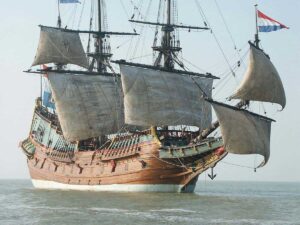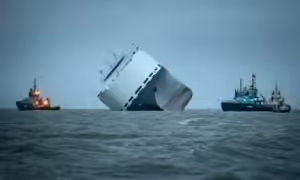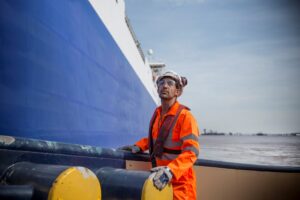Diving into history
This week Spring Safety Consultants took a deep dive into the history of Western Australia’s shipwrecks. Our work health and safety auditors visited the WA Shipwrecks Museum which is internationally recognised for its contributions to maritime archaeology and shipwreck conservation.
We learnt that the coastline of Western Australia is a stark reminder of the perils faced by seamen over the centuries. Scattered along this rugged shore are the remnants of shipwrecks, each with its own story of tragedy and loss. But one question lingers: did poor health and safety standards play a role in these maritime disasters?
The Historical Context
To understand the impact of health and safety on these shipwrecks, we must look back at the history of merchant seamen. Michael Quinlan’s article, “Precarious and Hazardous Work: The Health and Safety of Merchant Seamen 1815–1935,” offers a comprehensive overview of the harsh conditions faced by seafarers during this period. Quinlan highlights that merchant seamen often worked under precarious conditions, with long hours, inadequate rest, and minimal regard for their wellbeing. These factors undoubtedly contributed to the high incidence of accidents and fatalities at sea.
The Tale of the Batavia
One of the most infamous shipwrecks off the Western Australian coast is that of the Batavia. In 1629, this Dutch East India Company ship met its fate on the Abrolhos Islands. The story of the Batavia is not just one of a shipwreck but also of mutiny and murder. After the ship struck a reef, the survivors faced a desperate struggle for survival. The ensuing chaos revealed not only the dangers of the sea but also the brutal human consequences of inadequate leadership and poor conditions.
After it was all over, and all mutineers punished only 116 of 341 remained alive. The Batavia tragedy was a horrific incident in the history of Dutch travel and trade along the Western Australian coast, and is a story that has been kept alive for nearly four hundred years.
Health and Safety Standards: Then and Now
The Batavia’s tragic story and Quinlan’s research underline a crucial point: poor health and safety standards have historically been a significant factor in maritime disasters. Lack of proper medical care, insufficient training, and overworked crews were common, making ships vulnerable to accidents.
In modern times, the maritime industry has made strides in improving health and safety standards. Regulatory bodies have implemented rigorous safety protocols, and advancements in technology have enhanced navigation and emergency response capabilities. However, the lessons from the past remain relevant. Ensuring the health and wellbeing of seafarers is vital to preventing accidents and safeguarding lives.
Maritime Safety Today
Here are a few foreseeable factors (hazards/risks) can impact maritime safety:
- Fatigue and Stress: Seamen often work long hours with insufficient rest, leading to fatigue and impaired decision-making abilities. Chronic stress and fatigue can result in errors in navigation, communication, and machinery operation, increasing the risk of accidents.
- Poor Health: Seamen with health issues, whether physical or mental, may not perform their duties effectively. Medical emergencies at sea can also divert attention and resources away from essential tasks, potentially leading to accidents.
- Lack of Training: Insufficient training in safety protocols and emergency procedures can leave crew members unprepared to handle crises, leading to mishandling of situations that could have been contained or avoided.
- Unsafe Working Conditions: Hazardous working environments, lack of proper safety equipment, and non-compliance with safety regulations can lead to incidents and increase the likelihood of shipwrecks.
- Psychosocial Factors: Isolation, long periods away from family, and poor living conditions can affect the mental health of seamen, leading to decreased vigilance and higher chances of mistakes.
- Communication Issues: Poor health and wellbeing can affect the ability to communicate effectively, both within the crew and with external entities like port authorities and other vessels, leading to miscommunications that can result in incidents.
- Substandard Maintenance: Poor health and wellbeing can also be symptomatic of broader systemic issues within a shipping company, such as inadequate maintenance of the vessel. This can lead to mechanical failures and other technical issues that contribute to shipwrecks.
Conclusion
The shipwrecks off Western Australia’s coast serve as a poignant reminder of the perils faced by seamen throughout history. While not all shipwrecks can be attributed solely to poor health and safety standards, it is clear that these factors have played a significant role in many maritime disasters. By learning from the past and continually improving conditions for seafarers, we can help prevent future tragedies and ensure the safety of those who navigate the world’s oceans.
For a deeper understanding of the historical challenges faced by merchant seamen, you can read Michael Quinlan’s insightful article, “Precarious and Hazardous Work: The Health and Safety of Merchant Seamen 1815–1935,” and explore the harrowing story of the Batavia’s at WA Museum https://museum.wa.gov.au/explore/month-shipwrecks.
References
Michael Quinlan (2013) Precarious and hazardous work: the health and safety of merchant seamen 1815–1935, Social History, 38:3, 281-307, DOI: 10.1080/03071022.2013.812344
WA Museum (2024) Batavia’s History | Western Australian Museum









